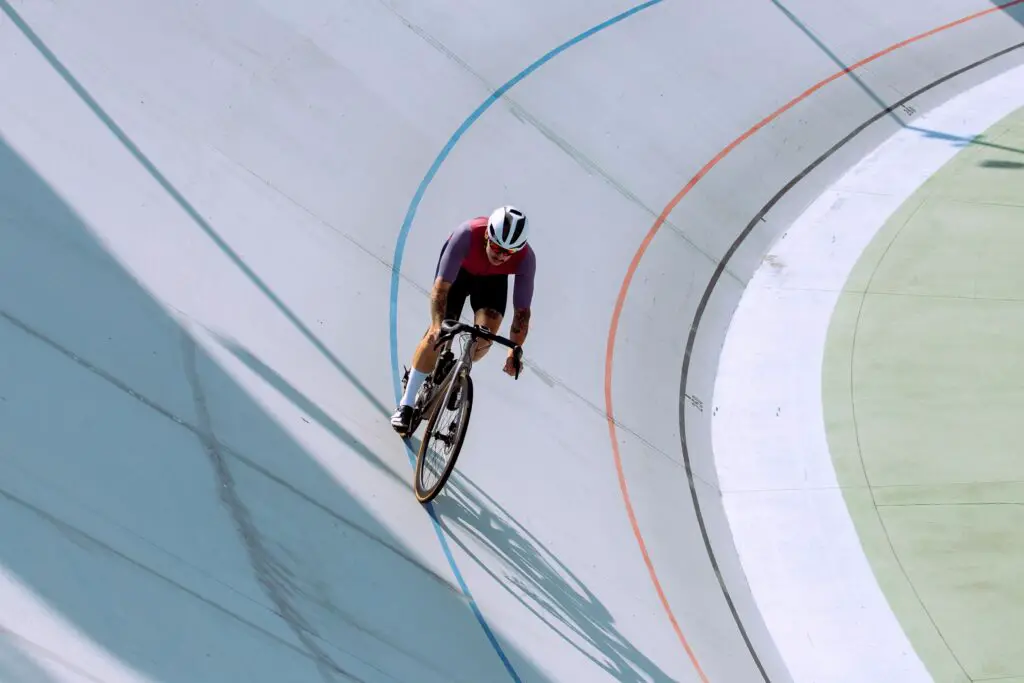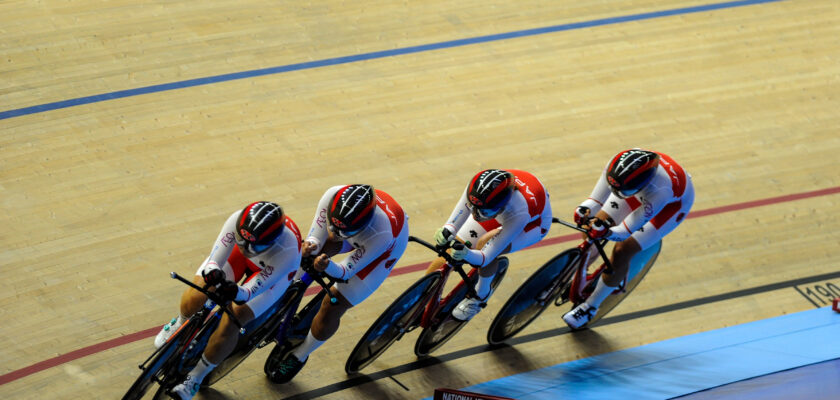Like the road races, Track Cycling was included in the program of the first edition of the Olympic Games of the Modern Era, in Athens-1896. Since then, this discipline has only been absent from one edition: Stockholm-1912, where only the road races were held. Learn all about Track Cycling now!
Open your account at Betano and get up to 1,000 reais in bonuses.
Payments via PIX, live games and super odds!
Click here to open your account!
All about Track Cycling: what is it?
Track cycling, also known as indoor cycling, is a type of cycling that takes place in a velodrome;
First introduced in 1870, this sport is practiced indoors, like the velodrome in Rio de Janeiro, which was used during the 2016 Olympic Games;
However, there are also open velodromes, such as those in Curitiba and Americana.

The main idea behind track cycling is to allow athletes to compete without the interference of weather conditions, as it is impractical to practise road cycling in adverse conditions such as snow, which is common in Europe.
Read to the end to find out all about Track Cycling!
One of the advantages of track cycling is the diversity of race types and the proximity of the public to the competitions, which increases spectator interest;
In addition, this discipline can serve as fundamental training for road cycling, as it allows athletes to develop various skills and identify their specialties, such as sprinter or passer.
Track cycling was introduced to the Olympic Games in 1896 in Athens, initially only for men. Women began competing in this sport at the 1988 Olympic Games in Seoul.
Read to the end to find out all about Track Cycling!
All about Track Cycling: history of the sport
The origins of track cycling are very similar to those of road cycling. The first official competitions date back to 1870, with athletes competing in closed gymnasiums with wooden tracks;
The main advantage of this aspect of cycling was that it didn’t depend on the weather and that spectators could charge for tickets.
In track cycling, speed is the crucial element. There are 10 different types of races, 5 for men and 5 for women;
In addition to the speed, team speed, keirin and team pursuit competitions, a new feature is the omnium;
Read to the end to find out all about Track Cycling!
Introduced at the London 2012 Games, this event sees athletes compete for points, taking part in chases, time trials and races. The winners are those who accumulate the most points over the course of the various events.
An interesting feature of track bikes is the absence of brakes and the presence of only one gear. Due to the high speeds reached by athletes, the use of brakes could cause accidents and pose a great risk;
In addition, women only started competing for medals in track cycling at the Olympic Games from Seoul-1988.
Read to the end to find out all about Track Cycling!
All about Track Cycling: the sport’s disciplines
With ten different types of competitions, track cycling has varying track sizes according to the number of athletes:
- 200 meters – 20 cyclists;
- 250 meters – 24 cyclists;
- 333 meters – 36 cyclists.
Types of Track Cycling Races
- Speed (Sprint): considered the fastest race, where two cyclists start at a slower pace, watching each other. Of the three laps, only the last is timed, and whoever crosses the finish line first wins.
- Team Sprint: with the teams positioned at opposite points, the teams are made up of three cyclists for men and two for women. Each rider leads a lap, making way for their teammate. The team with the shortest total time wins.
- Team Pursuit: two teams of four cyclists set off from opposite sides of the track, trying to catch their opponent or finish with the shortest time in a 4 km race. The cyclists take turns at the front to reduce wind resistance.
- Keirin: at the start of the race, the cyclists follow a bike that controls the speed, starting at 30 km/h and increasing to 50 km/h for men and from 25 km/h to 45 km/h for women. After leaving the bike, the speed can reach 70 km/h, with the winner crossing the finish line first.
Read to the end to find out all about Track Cycling!
- Omnium: consists of six different types of races, held over two days.
- Flying Lap: wins by completing the race in the shortest time, with three laps, only the last of which is timed.
- Scratch: a simple race of 16 km for men and 10 km for women, where whoever crosses the finish line first wins.
- Individual Pursuit: two cyclists start from opposite positions and the winner is whoever catches up with their opponent or finishes with the shortest time, over a course of 4 km for men and 3 km for women.
- Counter-clockwise: each cyclist races alone, and the winner is whoever completes the course in the shortest time, 1 km for men and 500 m for women.
- Elimination: in speed races, the last rider to cross the line after two laps is eliminated. The last remaining rider wins.
- Points Race: points are added up every 10 laps, ranging from 5 to 1, over distances of 30 km for men and 20 km for women. An additional 20 points are awarded to the rider who completes a full lap in the peloton.
Read to the end to find out all about Track Cycling!
All about Track Cycling: structure and equipment
Track cycling events take place on velodromes, tracks designed for this type of sport. But what is a velodrome?
Velodrome
This is a cycling track of varying sizes, which can measure 200, 250 or 333 meters, and is made of wood in closed gyms or concrete in open gyms.
The longer the track, the greater the number of cyclists it can accommodate, with a maximum of 36 athletes. Competitions always take place in an anti-clockwise direction.
The track is sloped to help riders maintain high speeds, similar to Nascar’s oval tracks.
In addition, the floor of the velodrome has three different colored lines (black, red and blue), each with a specific purpose:
Black line: located on the innermost part of the track, this line marks the minimum limit of the track. Cyclists may not cross this line from the left, as the official measurement of the track is made from this line. For example, on a 250-meter track, this line is exactly 250 meters long. Cycling to the left of it would result in a shorter distance.
Red line: demarcates the sprinter area. Within this space (between the black and red lines), overtaking from the left is not allowed. To overtake, the cyclist must be between the red and blue lines.
Blue line: Above this line is considered the rolling and warm-up area, keeping the left lanes free for other cyclists.
Read to the end to find out all about Track Cycling!
What are track bikes like?
The bikes used in track cycling are designed specifically for this sport;
They don’t have brakes or gears, in order to reduce weight as much as possible and make them extremely light, which makes it easier for athletes to reach high speeds.
There are two main styles of bikes adapted for the track, similar to those used in road cycling: road bikes and time trial bikes;
Both are modified to be even lighter and more efficient, suitable for the demands of velodrome competitions.
Read to the end to find out all about Track Cycling!
All about Track Cycling: race rules
The rules of track cycling may vary slightly depending on the specific competition, but some general rules are widely accepted and applied in official events. Here are some of the main points of the track cycling rules:
- Positioning on the track: there are lines demarcated on the track that have specific functions, such as the black line (inner line), which marks the minimum limit of the track, the red line, which delimits the sprinters’ area, and the blue line, used for warming up and rolling.
- Start and Finish: In speed races, cyclists usually start the race in a blocking position, with the aim of accelerating quickly until they reach their maximum speed. In pursuit races, teams start on opposite sides of the track and try to catch up or complete the race in the shortest time.
- Overtaking: in some races, especially in the pursuit, there are specific rules about where and how riders can overtake their opponents. For example, in a pursuit race, one rider can overtake another only in certain areas of the track.
- Disqualifications: riders can be disqualified for various infractions, such as leaving the track, touching or pushing other riders, or violating specific rules of the disciplines. It is essential to follow the referees’ instructions and the established rules to avoid penalties.
- Signals and Warnings: during races, referees and officials use signals and warnings to inform riders about the progress of the race, such as the number of laps remaining or the need to accelerate.
Read to the end to find out all about Track Cycling!
All about Track Cycling: curiosities
- In one of the disciplines, cyclists compete in part of the race following a motorized vehicle that can reach up to 50 km/h;
- Wearing a helmet is compulsory and is designed to improve aerodynamics in high-speed races;
- Women’s participation in track cycling at the Olympic Games began in Seoul 1988;
- The bikes used have no brakes or gears.
Did you already know about this sport? Now that you know all about Track Cycling, learn more about it too:



